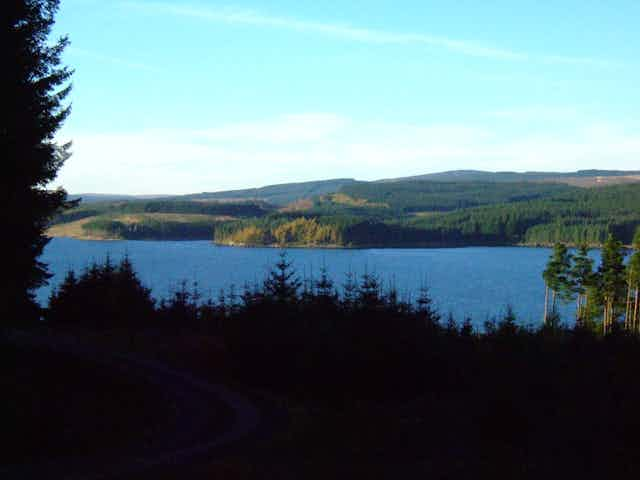Humans have cut down half the trees on Earth since the dawn of agriculture – over 3 trillion of them. This huge loss holds the potential for massive reforestation today, which would protect local environments from soil loss, flash flooding and desertification and take up large quantities of atmospheric carbon dioxide. Despite these advantages, reforestation gets very little attention in our fight against climate change.
Britain is ideal for tree growth due to its mild winters, plentiful rainfall, fertile soil and hill-sheltered topography, and it has growth rates higher than mainland Europe and Scandinavia.
Britain, without human interference, would be covered by mature oak woodland with some hazel, birch and pine further north. But England’s forest cover dropped as low as 5% after World War I, prompting the government to set up the Forestry Commission, which has helped increase forest cover over the last 80 years to nearly 10%.
Overall, UK forest cover is now 13%, nearly 3.17m hectares. This is one of the lowest levels in Europe, which has a forest cover averaging 35%. Japan has a similar population density to the UK, but has maintained 67% forest cover.
The UK government already has plans to create new habitats on 500,000 hectares of land by 2043, restoring forests, meadows and wetlands on about 2% of the UK’s area to mitigate and adapt to climate change. Each hectare that is rewilded will absorb the carbon emissions of 30 London buses or 90 cars for a year. If done correctly, this could take up a third of the annual carbon emissions of the UK.
UK forest and climate targets
This 2% target lacks ambition considering the government’s own Independent Panel on Forestry concluded in 2012 that the forested portion of England should rise to 15% by 2060 – a return to its Medieval level. This would mean reversing the decline in forest planting that has occurred over the last 30 years.
The Climate Change Committee recommends that the UK should have a 2050 zero carbon emissions target. If reforestation occurred across the whole of the UK, increasing the total forest cover to 18% and if all bogs, grasslands, arable and horticultural lands were managed in the best way possible, then these could account for one quarter of the required cuts by 2050.

If this mandate moves to a more stringent “zero carbon emissions” target for 2050, as suggested by the recent IPCC 1.5˚C report, then managing the British landscape could provide 25% of the solution.
Managing the natural landscape also has other benefits, from stabilising soils and preventing floods to ameliorating heatwaves and preserving biodiversity.

Global plant power
Using plants to combat climate change is an idea with plenty of supporters elsewhere in the world. Globally, mass forest restoration is already underway, with commitments across 43 countries to restore 292m hectares of degraded land to forest, ten times the area of the UK.
The IPCC special report on keeping global warming below 1.5°C makes a compelling case for agriculture and forestry taking a leading role in absorbing and mitigating carbon pollution.
Their recommendations include converting up to 8m km2 of pasture and up to 5m km2 of non-pasture agricultural land used for food and feed crops into at least 7m km2 used for energy crops. These energy crops will produce solid and liquid fuel that will replace fossil fuels.
They also recommend aggressive global reforestation targets. One suggestion is to take the 1m km2 of forest that has been lost over the last decade and replacing it with 10 million km2 of forest by 2050.
We can reduce carbon emissions from human land-use by restoring ecosystems, farming in a more sustainable way and encouraging a shift to less resource-intensive diets – a vegan diet emits a third of the carbon emissions of a meat dominated diet.
Reforestation success in China
Massive reforestation is not a pipe dream – there are excellent examples of it being done in the recent past. In the late 1990s environmental deterioration in China became critical, with vast areas resembling the dust bowl of the American Mid-west in the 1930s. Six large forest programmes were introduced during the late 1990s and early 2000s, targeting over 100m hectares of land for reforestation.
Grain for Green is the largest and best known of these programmes. It reduced soil erosion and desertification and stabilised local rainfall patterns.
The ongoing programme also helped to alleviate poverty, as payments are made directly to farmers who set aside their land for reforestation. It has also reduced China’s grain surplus, which was depressing prices, and helped to rebalance the inequality between the eastern and western provinces. The Grain for Green programme shows that widespread reforestation can have a very positive affect on the economy as well as the environment.
There is ample opportunity and land on which to reforest. Despite the rising population of the Earth, which is projected to hit 10 billion by 2050, there is a net migration from rural areas into urban areas. Outside of cities, the world is getting wilder as people move into dense urban populations. This opens even more areas that could be considered for rewilding.
Global reforestation should be considered an essential tool to combat climate change at COP24. For the UK delegation, some ambition to revive the country’s beautiful forests is long overdue.

